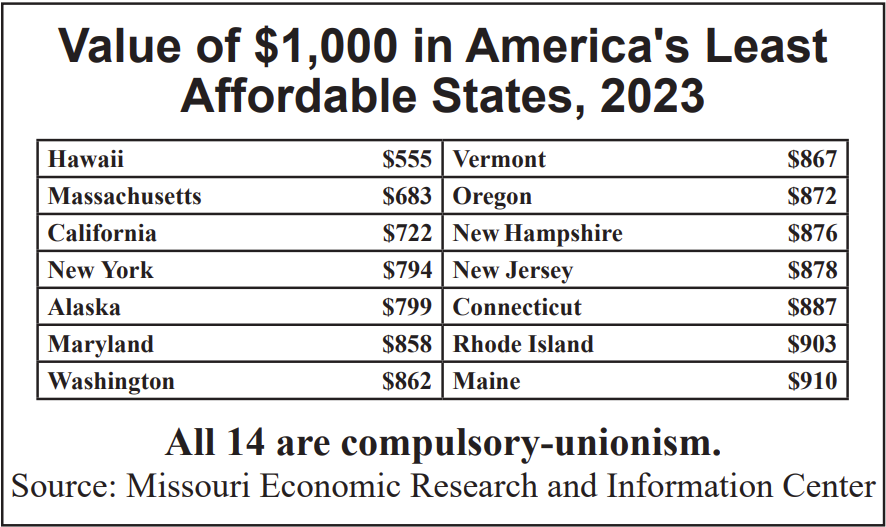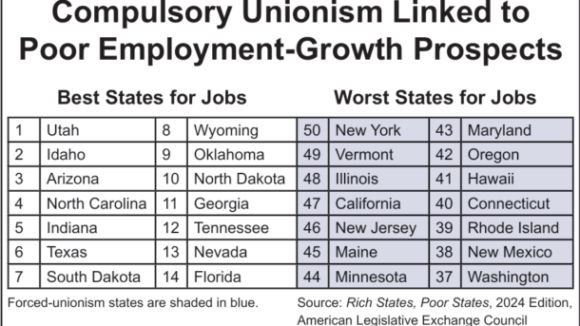Is This Any Way to Run a City’s Schools?
Leaked CTU Proposals Won’t Do Anything to Improve Schools’ Poor Performance

In early February, the Jefferson City-based Missouri Economic Research and Information Center (MERIC), a state government agency, published the latest update of its comparative state cost-of-living indices, covering 2023 as a whole.
As MERIC explains on its website, it “derives the cost of living index for each state by averaging the indices of participating cities and metropolitan areas in that state.”
(The city/metropolitan area indices are derived from an ongoing nationwide survey conducted by the nonpartisan, Arlington, Va.-based Council for Community and Economic Research.)
The MERIC indices released early this year estimate the 2023 average annual cost of living for each state.
The National Institute for Labor Relations Research has now used these data to calculate average 2023 costs of living for Right to Work states and forced-unionism states.
In 2023, 27 states had adopted and implemented Right to Work laws protecting employees from federal labor-law provisions authorizing forced union dues and fees as a job condition.
(Unfortunately, last year, one of these states, Michigan, repealed its Right to Work law, but the repeal did not take effect until February of this year.)
The 27 Right to Work states combined had a population-weighted cost of living of 94.5, 5.5% below the U.S. average.
The 23 forced-unionism states combined had a cost of living of 116.5, 16.5% above the national average.
Consequently, as a group, forced-unionism states are 23.2% more expensive to live in than Right to Work states.
(MERIC itself does not weigh states based on population size in calculating its indices. For that reason, the national average of population-weighted states does not equal 100.)
The correlation between forced-unionism status and a higher cost of living is robust. Not one of the 14 highest-cost states in 2023 has a Right to Work law.
But 14 of the 15 lowest cost-of-living states protected employees’ Right to Work in 2023.
John Kalb, vice president of the National Right to Work Committee, commented:
“A growing body of research shows that compulsory unionism fosters a higher cost of living. That’s not surprising.
“Union officials wielding forced-dues privileges funnel a large share of the conscripted money they reap into efforts to elect and reelect politicians who favor higher taxes and heavier regulation of business.
“And many economists credibly argue that excessive government regulation is a major factor behind high housing, energy and other costs in forced-unionism states like California, Oregon, New York, Massachusetts and Connecticut.
“Decades of academic studies by economists such as Thomas M. Carroll and Richard J. Cebula have demonstrated that one side benefit of Right to Work laws is that they help reduce the cost of living in jurisdictions where they are in effect.”
Mr. Kalb continued:
“Ignoring the findings of economists like Drs. Carroll and Cebula, Big Labor apologists like New Republic staff writer Tim Noah try to claim that Big Labordominated states’ unaffordability is somehow a sign of prosperity.
“But the annual net migration of hundreds of thousands of employees at all income levels out of forced-dues states and into Right to Work states exposes the absurdity of such claims.
“What matters most to employees seeking better lives for themselves and their families, and employers seeking to attract and retain good employees, is not nominal wages and salaries.
“It is what those wages and salaries can buy in the location where the employees and their families live.
“That’s why honest efforts to make comparisons of annual wages and salaries and other types of income in Right to Work states versus forced-unionism states must always be informed by MERIC’s, or some other nonpartisan, comparative cost-of-living index.
“For example, in 2022, the average real, disposable income per capita in Right to Work states was roughly $3,700 higher than the average in forced-unionism states, using MERIC’s indices to adjust U.S. Commerce Department data for regional cost-of-living disparities.
“America’s breadwinners clearly recognize they and their families are better off in Right to Work states. That’s why recent Census data show forced-dues states are on track to lose an additional net 2.2 million people in their peak-earning years, that is, aged 35-54, from 2020 to 2030.”
This article was originally published in our monthly newsletter. Go here to access previous newsletter posts.
To support our cause and help end forced unionism, go here to donate.

Leaked CTU Proposals Won’t Do Anything to Improve Schools’ Poor Performance

Wherever Big Labor wields the power to collect forced union dues, union bosses funnel a large share of the confiscated money into efforts to elect and reelect business-bashing politicians. Employment growth tends to lag as a consequence.

Members Insist They Keep Pro-Right to Work Campaign Promises